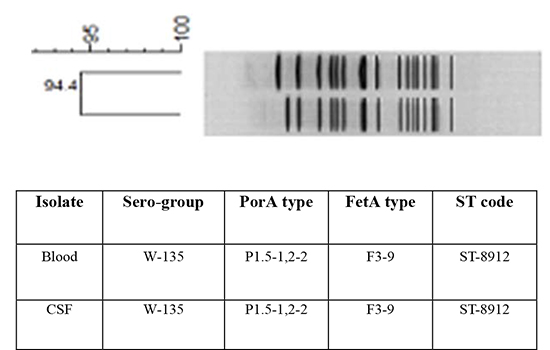1. Al-Tawfiq JA, Clark TA, Memish ZA. Meningococcal disease: the organism, clinical presentation, and worldwide epidemiology. J Travel Med. 2010; 17:3–8.
2. Quagliarello V. Dissemination of Neisseria meningitidis. N Engl J Med. 2011; 364:1573–1575.
3. Lee SO, Ryu SH, Park SJ, Ryu J, Woo JH, Kim YS. Meningococcal disease in the republic of Korea army: incidence and serogroups determined by PCR. J Korean Med Sci. 2003; 18:163–166.
4. Dolan Thomas J, Hatcher CP, Satterfield DA, Theodore MJ, Bach MC, Linscott KB, Zhao X, Wang X, Mair R, Schmink S, et al. sodC-based real-time PCR for detection of Neisseria meningitidis. PLoS One. 2011; 6:e19361.
5. Mothershed EA, Sacchi CT, Whitney AM, Barnett GA, Ajello GW, Schmink S, Mayer LW, Phelan M, Taylor TH Jr, Bernhardt SA, et al. Use of real-time PCR to resolve slide agglutination discrepancies in serogroup identification of Neisseria meningitidis. J Clin Microbiol. 2004; 42:320–328.
6. Bae SM, Kang YH. Serological and genetic characterization of meningococcal isolates in Korea. Jpn J Infect Dis. 2008; 61:434–437.
7. Thompson EA, Feavers IM, Maiden MC. Antigenic diversity of meningococcal enterobactin receptor FetA, a vaccine component. Microbiology. 2003; 149:1849–1858.
8. Korea Centers for Disease Control and Prevention. Infectious diseases surveillance yearbook, 2012. Seoul: Korea Centers for Disease Control and Prevention;2013.
9. Vyse A, Wolter JM, Chen J, Ng T, Soriano-Gabarro M. Meningococcal disease in Asia: an under-recognized public health burden. Epidemiol Infect. 2011; 139:967–985.
10. Kim JH, Jun YH, Jeong YS. Study on pharyngeal Neisseria meningitidis carrier rate of Korean army recrutis. J Korean Mil Med Assoc. 1990; 21:35–47.
11. Park HS, Chun YI. Vaccination effect on pharyngeal carrier rate of Neisseria meningitidis and its serogroups in Korea army recruits. J Korean Mil Med Assoc. 1992; 23:105–115.
12. Taha MK, Achtman M, Alonso JM, Greenwood B, Ramsay M, Fox A, Gray S, Kaczmarski E. Serogroup W135 meningococcal disease in Hajj pilgrims. Lancet. 2000; 356:2159.
13. Koumaré B, Ouedraogo-Traoré R, Sanou I, Yada AA, Sow I, Lusamba PS, Traoré E, Dabal M, Santamaria M, Hacen MM, et al. The first large epidemic of meningococcal disease caused by serogroup W135, Burkina Faso, 2002. Vaccine. 2007; 25:A37–A41.
14. Wilder-Smith A, Chow A, Goh KT. Emergence and disappearance of W135 meningococcal disease. Epidemiol Infect. 2010; 138:976–978.
15. Chiou CS, Liao JC, Liao TL, Li CC, Chou CY, Chang HL, Yao SM, Lee YS. Molecular epidemiology and emergence of worldwide epidemic clones of Neisseria meningitidis in Taiwan. BMC Infect Dis. 2006; 6:25.
16. Kim SA, Kim DW, Dong BQ, Kim JS, Anh DD, Kilgore PE. An expanded age range for meningococcal meningitis: molecular diagnostic evidence from population-based surveillance in Asia. BMC Infect Dis. 2012; 12:310.
17. Tsai TF. Meningococcal Disease and Quadrivalent MenACWY-CRM Vaccine (Menveo(R)). Korean J Pediatr Infect Dis. 2012; 19:89–110.







 PDF
PDF ePub
ePub Citation
Citation Print
Print




 XML Download
XML Download